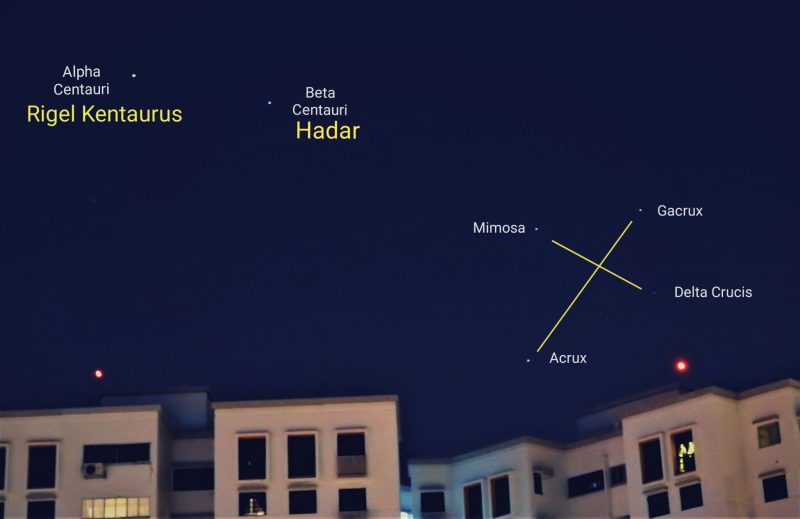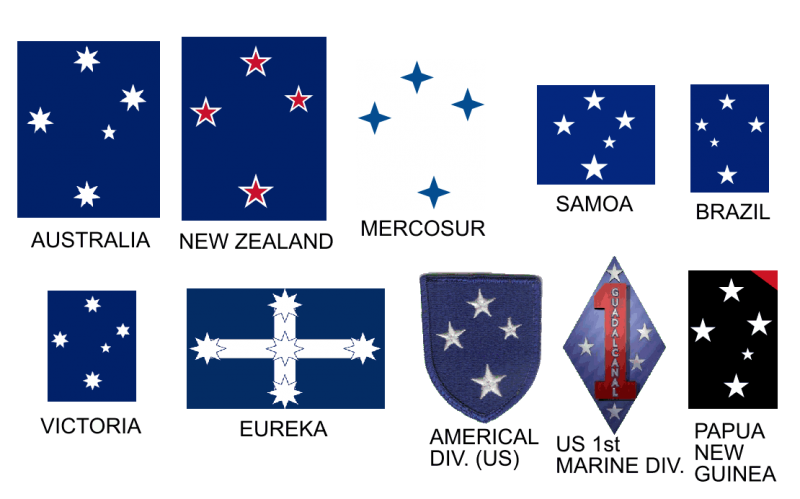
Acrux is in the Southern Cross
The star Acrux – aka Alpha Crucis – is the brightest star in the constellation of the Southern Cross. This constellation’s official name is Crux. The star Acrux is the 13th brightest star in all the sky. Because it’s located far to the south of the sky’s equator, this star isn’t visible from much of North America. You need to be south of central Florida or south Texas. Observers in Hawaii sometimes tell us they’ve seen it. It’s best to be farther south than the southern U.S. to see Crux in all its glory. Now is a good time of year to spot it, if you’re in the right place on the globe.
For us on the northern half of Earth’s globe, the southerly location of Crux and its stars are part of their magic and mystery. As Crosby, Stills and Nash said:
When you see the Southern Cross for the first time
You understand now why you came this way

Last chance to get a moon phase calendar! Only a few left. On sale now.
Acrux is really two stars
Acrux is located about 321 light-years from Earth. And it is, in fact, not one star but two nearly identical B-class stars. These can be resolved – separated – in a small telescope, making Acrux a nice double star. However, to the unaided eye, Acrux appears as a single star.
Using data from the Hipparcos mission. Acrux is classified as B0.5 IV, meaning that it is hotter, brighter, larger and more massive than our sun. The designation “IV” indicates that Acrux is a “subgiant” star, not big enough to be considered a giant. That’s because it has left the realm of normal stars (the main sequence) and has entered the later phases of stellar life. Eventually it will end up as a white dwarf star.
How to see Acrux
You need to be south of about 27 degrees north latitude – that is, no more north than 27 degrees north of the equator – to see Acrux and the Southern Cross. The farther south the better. From approximately the latitude of Brisbane, Australia – 27 degrees south latitude – the star becomes circumpolar and is visible every night of the year.
If you are far enough south to see them from the Northern Hemisphere, you might know they exhibit their midnight culmination (highest elevation above the southern horizon at midnight) in late March and early April. In other words, the best time for seeing them in the evening is during that time of the year.
Northern Hemisphere view
If you are in the Northern Hemisphere, facing south to see them, the star Acrux marks the bottom of the Southern Cross and is thus the star nearest the horizon. At a magnitude 0.77, Acrux is the southernmost 1st-magnitude star, that is, the southernmost of the brightest stars in our sky. Nearby Mimosa, or Beta Crucis, is fainter than Acrux with a magnitude of 1.25; Mimosa is the 19th brightest star in all the heavens.
Two nearby and brighter stars, Alpha Centauri (the closest star to Earth and a triple star system) and Beta Centauri (Hadar), are known as the Southern Pointers. A line drawn from Alpha through Beta, at about three times the distance between them, leads to the top of the Southern Cross, Theta Crucis.
History and mythology
Unlike many star names, which are Arabic, Latin or Greek proper names, Acrux is simply a combination of “A” (for Alpha) and Crux as the name of the constellation. Interestingly, its name was coined by Elijah Hinsdale Burritt, a Connecticut farm boy turned celestial cartographer, circa 1835.
While little mythology is associated with this star, and not much more (albeit some) with the entire constellation, the reputation of the Southern Cross is widespread. That might be because early sailors, moving southward on Earth’s globe, were thrilled to see it.
The Northern Cross – an asterism composed of the main stars of Cygnus the Swan – is larger and better shaped as a Christian cross, although it contains no stars as bright as Acrux. Interestingly, however, the brightest star in Cygnus, Deneb, is virtually the same apparent magnitude as Mimosa, the 2nd-brightest star in Crux. Both are bright blue stars of magnitude 1.25, ranking as the 19th (Mimosa) and 20th (Deneb) brightest stars in the sky.

Does it look like a cross?
Many point out that Crux, of which Acrux is the primary star, does not look exactly like a cross. They say it’s exaggerated like the rumors of Mark Twain’s death well before his actual demise. In fact, Twain wrote about the Southern Cross, when he viewed it for the first time and reported about it in his book, Following the Equator:
We saw the Cross to-night, and it is not large. Not large, and not strikingly bright. But it was low down toward the horizon, and it may improve when it gets up higher in the sky. It is ingeniously named, for it looks just as a cross would look if it looked like something else. But that description does not describe; it is too vague, too general, too indefinite. It does after a fashion suggest a cross – a cross that is out of repair – or out of drawing; not correctly shaped. It is long, with a short cross-bar, and the cross-bar is canted out of the straight line.
It consists of four large stars and one little one. The little one is out of line and further damages the shape. It should have been placed at the intersection of the stem and the cross-bar. If you do not draw an imaginary line from star to star it does not suggest a cross – nor anything in particular.
One must ignore the little star, and leave it out of the combination – it confuses everything. If you leave it out, then you can make out of the four stars a sort of cross – out of true; or a sort of kite – out of true; or a sort of coffin – out of true.
Despite Twain’s reluctance to be impressed, the Southern Cross is a well-loved constellation.
Bottom line: Acrux, also called Alpha Crucis, is the brightest star in the constellation Crux, the Southern Cross.











